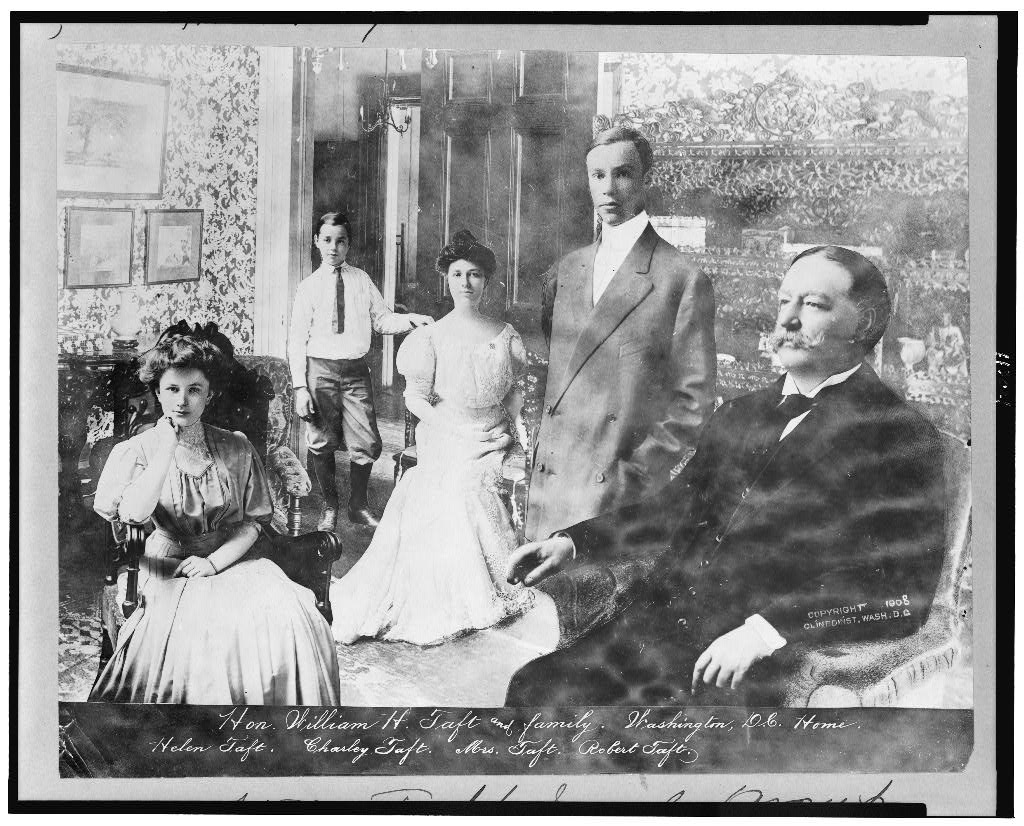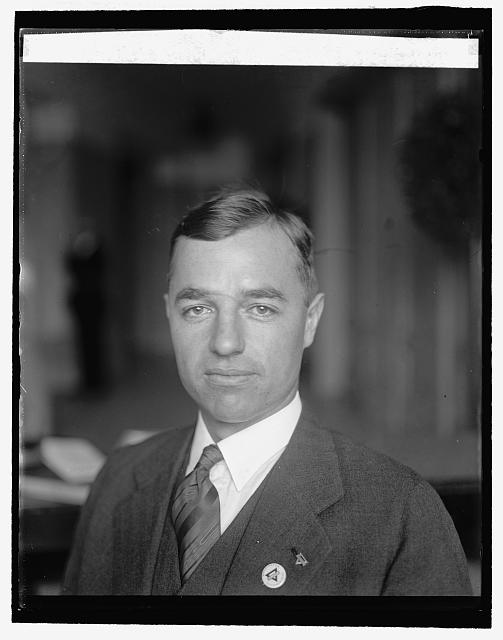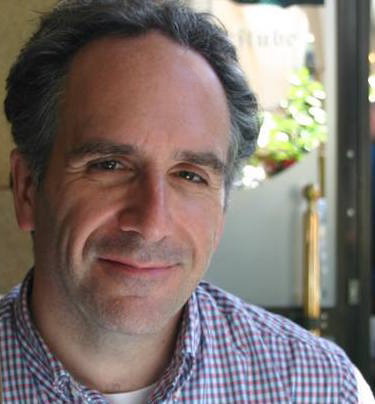

Presiona aquí para ver la versión en español
This is the second in a series of Grateful American Stories featuring the Presidential Children, adapted from the original series, “Stories About the Presidential Children.” Originally commissioned by the Grateful American Foundation, this piece was written by Edward G. Lengel and edited by David Bruce Smith. The Grateful American Foundation works to restore enthusiasm about history for kids – and adults.
Introduction

William Howard Taft was the twenty-seventh president of the United States. He and his wife Helen Louise Herron (known as Nellie) had three children that they named Robert, Helen, and Charles. All of them were born in Cincinnati, Ohio, and spent a lot of time there as they grew up. As children, the three Taft youngsters traveled with their distinguished parents throughout the United States and to countries like the Philippines. (William Howard Taft served as the Governor-General of the Philippines from 1900-1903.)[1] Only one of the children, however—youngest son Charles—lived as a child in the White House, during his father’s 1909-1913 presidency. All three were committed to learning and self-improvement, and would grow up to lead meaningful lives. Each one was brilliant in his or her own way.
Robert Alphonso Taft

Born on September 8, 1889, Robert A. Taft was a scholar from an early age. He attended school in his birthplace of Cincinnati, and then in the Philippines. His mother “Nellie” Taft made sure that all of her children learned about Filipino society. Returning to the United States, Robert Taft attended the Taft School in Watertown, Connecticut (founded in 1890 by his uncle Horace Taft), and then went to Yale University (New Haven, Connecticut) in 1906. He graduated with honors in 1910 from Yale; there, he was a member of the elite, secretive Skull and Bones Society and was voted the most scholarly man in his class. Taft then went to Harvard Law School in Cambridge, Massachusetts.
“I’m here to study,” Taft told reporters as he entered Harvard. “I do not intend to go into athletics or to be a social lion, or to do missionary work, or to be interviewed. I’m here to work hard. A fellow may go to college to have a good time, but when he gets through he thinks of more serious things. I thought of law.”[2] He was as good as his word. At Harvard, Taft excelled in his studies and edited the Harvard Law Review. He graduated in 1913 and then took the Ohio bar exam. He scored the highest in the entire state. Taft began practicing law in Cincinnati, and in 1914 he married the love of his life, Martha Wheaton Bowers. They would have four sons.
In 1919 Robert A. Taft went to work in Paris for Herbert Hoover’s American Relief Association, which fed millions of starving people, especially children, in war-torn Europe. Taft then entered politics and was elected to the Ohio House of Representatives in 1920. In the 1930s he served in the Ohio Senate. Taft was a deep thinker, supporting the Republican Party but also endorsing American membership in the League of Nations. He opposed Prohibition, and fought the Ku Klux Klan.
When Franklin D. Roosevelt became president in 1933, Taft criticized the president’s New Deal. Taft didn’t think it was the best way to tackle the Great Depression. His opposition to Roosevelt earned Taft the nickname “Mr. Republican.” Still, he supported banking regulations, unemployment insurance, senior pensions, and some federal relief programs. Elected to the U.S. Senate in 1938, where he would serve until his death, Taft advocated isolationism, or keeping the United States out of wars abroad.
Once the United States entered World War II, however, Taft supported the war effort. After the war, he stood behind the United Nations and the Marshall Plan for European relief. He also championed free speech, believing people had the right to criticize the government, even in wartime. For example, he attacked the Harry Truman administration’s handling of the Korean War. These opinions angered many of Taft’s fellow Republicans. As a result, he failed to gain his party’s nomination for the presidency. After he died from cancer in 1953, however, Taft was recognized as one of the leading political thinkers of his generation. His body lay in state in the rotunda of the United States Capitol.
Helen Herron Taft
Born on August 1, 1891, Helen Taft broke barriers in her lifetime quest for achievement. As a teenager, she attended Washington, D.C.’s Cathedral School. There she became friends with President Theodore Roosevelt’s youngest daughter, Ethel. When her father was elected president in 1908, seventeen-year-old Helen had just entered Bryn Mawr College in Pennsylvania on a scholarship. She “probably takes as little interest in social matters as any young woman ever called upon to grace the White House,” complained one newspaper article. “Books and study are her delights. . . . She likes outdoor sports, but social matters so far have occupied her mind least of all.”[3]
Helen’s mother suffered a stroke in 1909, and so she moved into the White House to assist her parents. Helen took on the social functions of a First Lady. At her “coming out” in 1910, newspapers were only interested in her physical appearance and social prospects.[4] She, however, had other ideas. She returned to Bryn Mawr after her mother’s recovery. Helen Taft then resumed her studies and graduated with a degree in history in 1915. Her record was so distinguished that the college appointed her dean in 1917 when she was only twenty-six years old. Two years later she became Bryn Mawr’s acting president.
Helen Taft was an outspoken advocate of women’s suffrage. This was only one of many ways she ruffled feathers at the university. She also argued that professors should form a union and strike for higher salaries. [5] After a year as Bryn Mawr’s president she moved on to continue her studies at Yale. There she earned a doctorate in British colonial history. Helen returned to Bryn Mawr in 1925, once more as a dean. She served in that role until 1941, and then became a history professor until her retirement in 1957. In 1920 she married another history professor, Frederick Johnson Manning, who taught at Yale and Pennsylvania’s Swarthmore College. Together they had two daughters. By the time of her death in 1987, Helen Taft Manning had authored two books. She had also become a leading member of organizations such as the Women’s International League for Peace and Freedom and the American Association of University Women.
Charles Phelps Taft II

The youngest son of William H. and Nellie Taft was born in Cincinnati on September 20, 1897. He spent his early years abroad as his father governed the Philippines. Returning to the United States while his father served as President Theodore Roosevelt’s Secretary of War, young Charles often frolicked with the Roosevelt children in the child-friendly White House. Afterwards, he followed his older brother Robert’s example by enrolling first in the Taft School and then in Yale University. There he stood out for his academic accomplishments. He was also an outstanding football player. In 1917, he married Eleanor Kellogg Chase. The two of them would go on to have seven children together. Charles dropped out of Yale when the United States entered World War I that year. He went to Europe to get a commission in the artillery. Despite the interruption, he graduated from Yale in 1918. Taft coached football for a year, and then graduated from Yale Law School in 1921. Passing the bar exam, he moved immediately into law practice in Ohio.
More easygoing and extroverted than his scholarly brother Robert, Charles Taft stayed out of national politics. Instead, he devoted himself to his family, fishing, and being a sports fan. He also focused on his law practice, on charity, and on the affairs of his beloved city of Cincinnati. Taft served as city mayor from 1955-1957, but worked as a city councilman for much longer. He passed away in 1983, having led a quieter but just as accomplished life as his brother and sister.
Notes
[1] The group of islands known as the Philippines was colonized by the Spanish in the late 1500s. In 1898, following their loss of the Spanish-American War, Spain ceded the Philippines to the United States. The Philippines again became an independent nation on July 4, 1946.
[2] Washington Post (1910) “Young Taft Studies Law. Enters Harvard to Work, He Says, and Has “Got Past” Athletics.” Washington Post, October 3, 1910.
[3] Ocala Evening Star (1908) “Latest Portrait of Miss Helen Taft,” Ocala Evening Star, Dec. 31, 1908.
[4] “Coming out” in this example is when a young, high-society woman is presented publicly to her new peers at a debutante ball. It is a rite of passage signifying that the woman has reached adulthood. These balls can be hosted by a community or by the person’s family.
[5] Oregon Daily Journal (1919) “Helen Taft Favors Professors Striking For Higher Salaries.” Oregon Daily Journal, Sept. 28, 1919.
About the Editor

David Bruce Smith is the President of the Grateful American Foundation and Founder of the Grateful American Book Prize. The Grateful American Foundation is a National Partner with America250.
About the Author

Edward G. Lengel is Chief Historian at the National Medal of Honor Museum. He received his Ph.D. from the University of Virginia, where he was a full professor and directed the Washington Papers Project for many years. He then served as Chief Historian of the White House Historical Association; wrote the new history of Colonial Williamsburg as a “Revolutionary in Residence;” and worked as Senior Director of Programs at the National WWII Museum. Also a professional author, speaker and battlefield tour guide, Lengel has written fourteen books on American history, including General George Washington: A Military Life, and Never in Finer Company: The Men of the Great War’s Lost Battalion. Lengel is a co-recipient of the National Humanities Medal and has won two writing awards from the Army Historical Foundation. He has made frequent television and radio appearances on The History Channel, SiriusXM, National Public Radio, and many others.
Keywords
Ohio; Connecticut; Massachusetts; Washington DC; Pennsylvania; Women
Suggested Articles
Self-Advocacy and U.S. Disability History
Rev. Dr. Pauli Murray: Unstoppable Force for Justice
Theodore Roosevelt’s Children

America’s Field Trip Awardees!
Thousands of students from across the country submitted inspiring entries, responding to the prompt “What does America mean to you?” for the first-ever America’s Field Trip contest. A panel of current and former educators selected 150 students as awardees, hailing from 44 states and territories.
